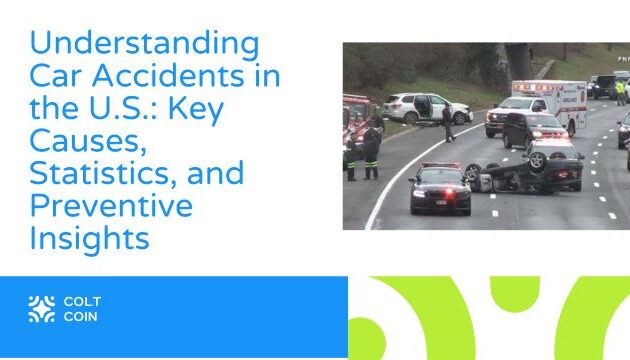The Reality of Car Accidents
Car accidents are an unfortunate yet common reality on U.S. roadways. In 2022 alone, there were 42,514 fatalities due to motor vehicle crashes, while a staggering total of 5.93 million accidents were reported to the police. These incidents resulted in millions of injuries and substantial property damage. Understanding the causes and dynamics of car accidents is essential for reducing risks and improving safety on the road.
Key Statistics on Car Accidents

- Total Reported Incidents: In 2022, the United States witnessed 5,930,496 motor vehicle crashes, including both fatal and non-fatal accidents.
- Fatalities: There were 42,514 deaths, marking a 1% decrease from 2021’s total of 43,230 fatalities.
- Injuries: 1,664,598 crashes resulted in injuries, with an estimated financial burden of $481.2 billion.
- Pedestrian Deaths: 7,522 pedestrians lost their lives, with 25% of these incidents involving hit-and-run drivers.
- Traffic Fatality Causes: Motor vehicle accidents rank as the second leading cause of unintentional injury deaths in the U.S.
Main Causes of Car Accidents
Accidents are frequently the result of human error, often preventable with proper attention and safe driving behaviors. The following are the leading contributors:
- Drunk Driving: Alcohol-impaired driving was responsible for 13,524 fatalities in 2022, accounting for 32% of all traffic deaths. This alarming statistic emphasizes the need for stricter enforcement and awareness.
- Time and Location Trends: 67% of DUI-related accidents occurred at night, with states such as Rhode Island and South Carolina reporting the highest rates of fatal DUI incidents.
- Speeding: Speeding contributed to 29% of all traffic fatalities, with 12,151 people losing their lives in 2022 due to excessive speed. South Carolina reported the highest rate of speed-related deaths, at 46% of fatal accidents.
- Impact of Speeding: Higher speeds not only increase collision risks but also amplify the severity of injuries.
- Lack of Seatbelt Use: Despite widespread laws mandating seatbelt use, nearly half of the 25,420 vehicle occupants killed in crashes in 2022 were unbuckled. This underscores the critical importance of seatbelt compliance.
- Distracted Driving: Distractions claimed 3,308 lives and caused 289,310 injuries in 2022. Common distractions include cell phone usage, eating, and other activities that take attention away from the road.
- Drowsy Driving: Fatigued driving remains a hidden danger, responsible for approximately 6,400 deaths each year. Drivers who operate vehicles while tired face slowed reaction times and impaired judgment, similar to those under the influence of alcohol.
Demographics and Accident Risks
Car accidents affect people of all ages, but certain groups are at higher risk due to specific behaviors or vulnerabilities.
- Teen Drivers: Young drivers aged 13-19 are more likely to be involved in fatal crashes due to inexperience and risky behaviors. In 2022, 2,883 teens lost their lives, with 56% of victims riding with peers at the time of the accident.
- Alcohol and Teens: Nearly 19% of impaired drivers in fatal accidents were between 15-20 years old.
- Elderly Drivers: Drivers aged 70 and older face increased accident risks due to age-related changes in reaction time and cognition. More than 7,515 people aged 65+ died in 2020 alone.
- Gender Differences: Men are statistically more likely than women to die in crashes. In 2022, 30,669 male fatalities were recorded compared to 11,737 female deaths. This disparity is partially attributed to higher rates of risky driving behaviors among men, including speeding and aggressive driving.
Geographic Trends
The likelihood of car accidents varies significantly across different states and regions.
- Urban vs. Rural Areas: In 2022, 25,023 fatalities occurred in urban settings, while rural areas reported 17,283 deaths. Urban congestion and complex traffic patterns contribute to higher accident rates.
- State-Specific Data: California had the highest number of total traffic fatalities (4,428 deaths), while the District of Columbia recorded the lowest (32 fatalities). States with high DUI rates, such as South Carolina and Rhode Island, also show elevated fatality rates.
Impact of Seatbelt Use
Seatbelt usage remains a critical factor in survival during crashes. Although 92% of adults report wearing seatbelts in the front seat, many fatalities involve unbuckled occupants. Efforts to increase compliance through education and enforcement are essential to reduce preventable deaths.
Car Accidents by Time and Day
- Time of Day: The afternoon and evening hours (3:00 PM – 9:00 PM) pose the highest risk for fatal crashes.
- Days of the Week: Weekend days, including Friday through Sunday, see nearly half of all fatal crashes. Tuesdays report the fewest fatalities, highlighting variations based on daily activity patterns.
Holiday Risks
Holidays often bring increased road risks due to higher travel volumes and celebrations involving alcohol. Independence Day ranks as the deadliest day of the year, averaging 143 fatal crashes.
Accident Types and Vehicle Categories
Certain types of vehicles and modes of transport face greater risks.
- Motorcycles: Riders are at increased risk of severe injury or death, with 6,218 fatalities reported in 2022.
- Pedestrians and Cyclists: Pedestrians faced 7,522 fatalities, while 1,105 pedalcyclists lost their lives.
- Light and Heavy Trucks: Light trucks accounted for 12,729 fatal accidents, highlighting unique challenges associated with different vehicle types.
Reducing Car Accident Risks
Preventing accidents requires a multi-faceted approach, including public education, policy enforcement, and technology-driven safety measures such as advanced driver-assistance systems. Strategies to reduce speeding, discourage impaired and distracted driving, and improve seatbelt compliance are vital for safer roads.
Conclusion: Toward Safer Roadways
While the statistics are sobering, they highlight opportunities for positive change. Through targeted interventions, public awareness campaigns, and individual commitment to safe driving practices, we can reduce accidents and save lives. For tailored legal support after a motor vehicle accident, consider consulting a specialized attorney.




